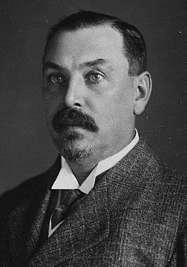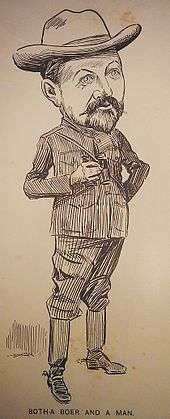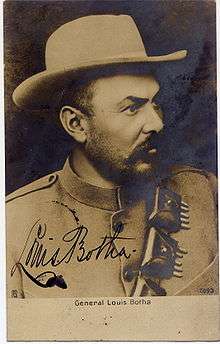Louis Botha
Louis Botha (Afrikaans pronunciation: [ˈlu.i ˈbuəta]; 27 September 1862 – 27 August 1919) was a South African politician who was the first Prime Minister of the Union of South Africa—the forerunner of the modern South African state. A Boer war hero during the Second Boer War, he would eventually fight to have South Africa become a British Dominion.
Louis Botha | |
|---|---|
 | |
| 1st Prime Minister of South Africa | |
| In office 31 May 1910 – 27 August 1919 | |
| Monarch | George V |
| Governor-General | The Viscount Gladstone The Earl Buxton |
| Preceded by | Office Established |
| Succeeded by | Jan Christiaan Smuts |
| Prime Minister of the Transvaal | |
| In office 4 March 1907 – 31 May 1910 | |
| Monarch | Edward VII George V |
| Governor | The Earl of Selborne |
| Preceded by | Office Established |
| Succeeded by | Himself As Prime Minister of South Africa |
| Personal details | |
| Born | 27 September 1862 Greytown, Colony of Natal |
| Died | 27 August 1919 (aged 56) Pretoria, South Africa |
| Resting place | Heroes' Acre, Pretoria, South Africa |
| Nationality | Afrikaner |
| Political party | South African Party |
| Other political affiliations | Het Volk Party |
| Spouse(s) | Annie Emmett |
| Profession | Career military officer, politician |
| Signature |  |
| Military service | |
| Allegiance | |
| Years of service | 1899–1902 (Transvaal Commandos) 1902-1919 (British Imperial Armies) |
| Rank | General |
| Commands | Boer, South African Republic |
| Battles/wars | Second Boer War: –Colenso –Spioen kop – Retreat from Pretoria First World War: –South-West Africa Campaign |
In 1905, as prime minister, he called for the newly discovered Cullinan Diamond to be presented to King Edward VII.
Early life
Louis Botha was born in Greytown, Natal, South Africa one of 13 children born to Louis Botha Senior (26 March 1827 – 5 July 1883) and Salomina Adriana van Rooyen (31 March 1829 – 9 January 1886). He briefly attended the school at Hermannsburg before his family relocated to the Orange Free State. The name Louis runs throughout the family, with every generation since General Louis Botha having the eldest son named Louis.
First Boer War
Louis Botha led "Dinuzulu's Volunteers", a group of Boers that had supported Dinuzulu against Zibhebhu in 1884.
Politician
Botha later became a member of the parliament of Transvaal in 1897, representing the district of Vryheid.

Second Boer War
Early battles
In 1899, Louis Botha fought in the Second Boer War, initially joining the Krugersdorp Commando,[1] continuing to fight under Lucas Meyer in Northern Natal, and later as a general commanding and leading Boer forces impressively at Colenso and Spion Kop. On the death of P. J. Joubert, he was made commander-in-chief of the Transvaal Boers, where he demonstrated his abilities again at Belfast-Dalmanutha. After the battle at the Tugela, Botha granted a twenty-four-hour armistice to General Buller to enable him to bury his dead.[2]
Capture of Winston Churchill
Winston Churchill revealed[3] that General Botha was the man who captured him at the ambush of a British armoured train on 15 November 1899. Coetzer 1996, p. 30 also claims that Botha captured Churchill at train ambush 15 November 1899. Churchill was not aware of the man's identity until 1902, when Botha travelled to London seeking loans to assist his country's reconstruction, and the two met at a private luncheon. The incident is also mentioned in Arthur Conan Doyle's book, The Great Boer War, published in 1902. But more recent sources claim that Field-Cornet Sarel Oosthuizen was in fact the Boer-soldier who, at gunpoint, captured Churchill.[4] Another version claims that the unit to capture Churchill was the Italian Volunteer Legion and its commander, Camillo Ricchiardi.[5]
Later campaigns
After the fall of Pretoria in June 1900, Louis Botha led a concentrated guerrilla campaign against the British together with Koos de la Rey and Christiaan de Wet. The success of his measures was seen in the steady resistance offered by the Boers to the very close of the three-year war.
Role after the Boer War

Botha was prominent in efforts to achieve a peace with the British, representing the Boers at the peace negotiations in 1902, and was signatory to the Treaty of Vereeniging. In the period of reconstruction under British rule, Botha went to Europe with de Wet and de la Rey to raise funds to enable the Boers to resume their former avocations.[6] Botha, who was still looked upon as the leader of the Boer people, took a prominent part in politics, advocating always measures which he considered as tending to the maintenance of peace and good order and the re-establishment of prosperity in the Transvaal. His war record made him prominent in the politics of Transvaal and he was a major player in the postwar reconstruction of that country, founding with Jan Smuts the Het Volk Party in the Transvaal Colony in 1904, which served as a springboard to campaign for responsible self-government for the colony.
After the grant of self-government to the Transvaal on 6 December 1906 and the success of his Het Volk Party at the first elections in February 1907, Botha was called upon by Lord Selborne to form a government as Prime Minister on 4 March 1907, and in the spring of the same year he took part in the conference of colonial premiers held in London. During his visit to England on this occasion General Botha declared the wholehearted adhesion of the Transvaal to the British Empire, and his intention to work for the welfare of the country regardless of (intra-white) racial differences.
In 1911, together with another Boer war hero, Jan Smuts, he formed the South African Party, or SAP. Widely viewed as too conciliatory with Britain, Botha faced revolts from within his own party and opposition from James Barry Munnik Hertzog's National Party. He was a South African Freemason.[7] When South Africa obtained dominion status in 1910, Botha became the first Prime Minister of the Union of South Africa.
Later career

After the First World War started, he sent troops to take German South-West Africa, a move unpopular among Boers, which provoked the Boer Revolt.
At the end of the War he briefly led a British Empire military mission to Poland during the Polish-Soviet War. He argued that the terms of the Versailles Treaty were too harsh on the Central Powers, but signed the treaty. Botha was unwell for most of 1919. He was plagued by fatigue and ill-health that arose from his robust waist-line.[8] That he was fat is certain as related in the marvellous account of Lady Mildred Buxton asking General Van Deventer if he was bigger than Botha, to which Van Deventer replied: “I am longer, he is thicker.”[9] (In Afrikaans thicker literally means fatter, and does not differentiate between long and tall)
Death
General Louis Botha died of heart failure at his home following an attack of Spanish influenza on 27 August 1919 in the early hours of the morning. He was 56. His wife Annie was at home and was joined by Engelenburg who had acted as a private secretary to Botha.[10][11] Botha was laid to rest in Heroes' Acre, Pretoria.
Of Botha, Winston Churchill wrote in Great Contemporaries, "The three most famous generals I have known in my life won no great battles over a foreign foe. Yet their names, which all begin with a 'B', are household words. They are General Booth, General Botha and General Baden-Powell..."[12]
Honors
Sculptor Raffaello Romanelli created the equestrian statue of Botha that stands in front of the South African Parliament building.
References
- "Italian Volunteer Legion (The English War 1899-1902) - Piet Rudolph". www.volkstaat.net. Retrieved 17 October 2018.
- MacBride 2006, p. 43.
- Churchill 1996, p. 253.
- "Churchill, Sir Winston". Prominent people. 14 July 2013. Retrieved 3 October 2016.
- Lupini, Mario. "Italian participation in the Anglo-Boer War". The South African Military History Society. Retrieved 17 February 2015.
- "Boer Leaders Coming Here: Botha and De la Rey to Visit America" (PDF). The New York Times. 30 July 1902. p. 3.
- "Notable South African Freemasons" (PDF). Freemasons.org.za. Retrieved 13 September 2018.
- Engelenburg 1928, pp. 350–53.
- Meintjes 1970, p. 292.
- Engelenburg 1928, p. 355.
- Meintjes 1970, p. 302.
- Churchill 1948, p. 287.
Sources
- Churchill, Winston (1948) [1937]. Great Contemporaries. London: Odhams.CS1 maint: ref=harv (link)
- Churchill, Winston (1996). My Early Life: 1874–1904. Scribner. ISBN 978-0-684-82345-4.CS1 maint: ref=harv (link)
- Coetzer, Owen (1996). The Anglo-Boer War: The road to Infamy, 1899–1900. W. Waterman. ISBN 978-1-874959-10-6.CS1 maint: ref=harv (link)
- Engelenburg, Frans Vredenrijk (1928). General Louis Botha. J.L. Van Schaik.CS1 maint: ref=harv (link)
- MacBride, John (2006). Jordan, Anthony J. (ed.). Boer War to Easter Rising: The Writings of John MacBride. Westport. ISBN 978-0-9524447-6-3.CS1 maint: ref=harv (link)
- Meintjes, Johannes (1970). General Louis Botha: a biography. Cassell.CS1 maint: ref=harv (link)

- Peace of Vereeniging
- . Encyclopædia Britannica (12th ed.). 1922.
Further reading
| Wikimedia Commons has media related to Louis Botha. |
Biographical
- Spender, Harold (1916). General Botha, The Career And The Man. London: Constable.
Historical
- Farwell, Bryon (1976). The Great Boer War. London: Allen Lane. (insights of Botha)
- Williams, Basil (1946). Botha Smuts and South Africa. London: Hodder and Stoughton. (comprehensive commentaries on Smuts and Botha, or as William's titled them in the last chapter of this book par nobile fratrum:203
- C.J.Barnard (1970). Generaal Louis Botha Op Die Natalse Front 1899-1900. Cape Town: A.A. Balkema.
Fiction
- O'Brien, Antony (2006). Bye-Bye Dolly Gray (illustrated ed.). Hartwell: Artillery Publishing. ISBN 9780975801321. (a heroic Boer character in this Australian/Boer War novel)
External links
| Wikiquote has quotations related to: Louis Botha |
- Newspaper clippings about Louis Botha in the 20th Century Press Archives of the ZBW
- Anne Samson: Botha, Louis, in: 1914-1918-online. International Encyclopedia of the First World War.
| Government offices | ||
|---|---|---|
| New title | Member of Parliament for Standerton 1907–1910 |
Replaced by Transvaal Provincial Council |
| Political offices | ||
| New title | Prime Minister of the Transvaal 1907–1910 |
Merged to form Union of South Africa |
| Minister for Agriculture 1907–1910 | ||
| House of Assembly of South Africa | ||
| Preceded by Jacobus Dreyer |
Member of Parliament for Losberg 1910–1919 |
Succeeded by ?? |
| Political offices | ||
| New title | Prime Minister of South Africa 1910–1919 |
Succeeded by Jan Smuts |
| New title | Minister of Agriculture 1910–1912 |
Succeeded by J. W. Sauer |
| Preceded by J. W. Sauer |
Minister of Agriculture 1912–1913 |
Succeeded by Harry van Heerden |
| Preceded by J. W. Sauer |
Minister of Native Affairs 1913–1919 |
Succeeded by Jan Smuts |
| Party political offices | ||
| New title | Leader of the Het Volk Party 1904–1911 |
Merged to form South African Party |
| New title | Leader of the South African Party 1910–1919 |
Succeeded by Jan Smuts |
.svg.png)